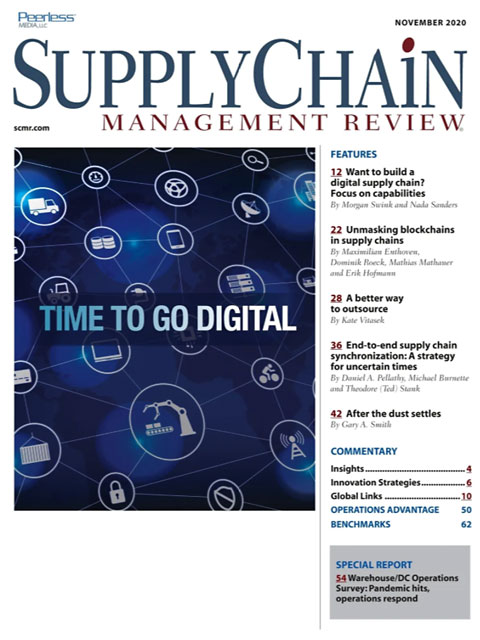Sorry, but your login has failed. Please recheck your login information and resubmit. If your subscription has expired, renew here.
November 2020
Supply chains have been in the spotlight like never before over the last eight months. That hasn’t always been a good thing. The perception, reinforced by shortages of products essential to our daily lives, is that supply chains were not up to the task and failed. The reality, as argued by MIT’s Yossi Sheffi in his new book, “The New (Ab)Normal: Reshaping Business and Supply Chain Strategy Beyond COVID-19,” is that supply chains performed as designed—they did what we expected them to do. Browse this issue archive.Need Help? Contact customer service 847-559-7581 More options
This represents my fifth e-tailing update about the evolution of consumer e-commerce. The series has chronicled the evolution of e-tailing from the eyes of a supply chain analyst. It has primarily focused on the battles between the heavy-weights, brick-and-mortar Walmart and e-tailer Amazon, as a reflection of what has been happening in the industry.
In my last column, “Supply chain heroes and lessons from COVID-19,” I discussed the breakdown of two basic-need supply chains—food and medical supplies. I stated that what we have learned during the pandemic is that, despite creating very efficient supply chains, our efforts have sometimes fallen short of meeting some basic needs, even in affluent countries.
The U.S. food chain is really two distinct ones. The grocery industry that serves home consumption—think grocery stores and business-to-consumer (B2C)—and the other is the food service industry that delivers to restaurants and other commercial institutions for food consumed outside of the home (B2B). Prior to COVID-19, that second supply chain accounted for the majority of U.S. food expenditures, as Americans dined away from home more. Thus, this year’s update is all about COVID-19’s impact on e-tailing, because the disruption in the food supply has drastically affected the overall retail picture.

This complete article is available to subscribers only.
Log in now for full access or start your PLUS+ subscription for instant access.
SC
MR
Sorry, but your login has failed. Please recheck your login information and resubmit. If your subscription has expired, renew here.
November 2020
Supply chains have been in the spotlight like never before over the last eight months. That hasn’t always been a good thing. The perception, reinforced by shortages of products essential to our daily lives, is that… Browse this issue archive. Access your online digital edition. Download a PDF file of the November 2020 issue.This represents my fifth e-tailing update about the evolution of consumer e-commerce. The series has chronicled the evolution of e-tailing from the eyes of a supply chain analyst. It has primarily focused on the battles between the heavy-weights, brick-and-mortar Walmart and e-tailer Amazon, as a reflection of what has been happening in the industry.
In my last column, “Supply chain heroes and lessons from COVID-19,” I discussed the breakdown of two basic-need supply chains—food and medical supplies. I stated that what we have learned during the pandemic is that, despite creating very efficient supply chains, our efforts have sometimes fallen short of meeting some basic needs, even in affluent countries.
The U.S. food chain is really two distinct ones. The grocery industry that serves home consumption—think grocery stores and business-to-consumer (B2C)—and the other is the food service industry that delivers to restaurants and other commercial institutions for food consumed outside of the home (B2B). Prior to COVID-19, that second supply chain accounted for the majority of U.S. food expenditures, as Americans dined away from home more. Thus, this year’s update is all about COVID-19’s impact on e-tailing, because the disruption in the food supply has drastically affected the overall retail picture.
 SUBSCRIBERS: Click here to download PDF of the full article.
SUBSCRIBERS: Click here to download PDF of the full article.
SC
MR


Latest Supply Chain News
- How CPG brands can deliver on supplier diversity promises
- How S&OP provides the answer to in-demand products
- AI, virtual reality is bringing experiential learning into the modern age
- Humanoid robots’ place in an intralogistics smart robot strategy
- Tips for CIOs to overcome technology talent acquisition troubles
- More News
Latest Podcast

 Explore
Explore
Procurement & Sourcing News
- How CPG brands can deliver on supplier diversity promises
- How S&OP provides the answer to in-demand products
- There is still work to do to achieve supply chain stability
- Blooming success: The vital role of S&OE in nurturing global supply chains
- How one small part held up shipments of thousands of autos
- Shining light on procurement’s dark purchases problem
- More Procurement & Sourcing
Latest Procurement & Sourcing Resources

Subscribe

Supply Chain Management Review delivers the best industry content.

Editors’ Picks





